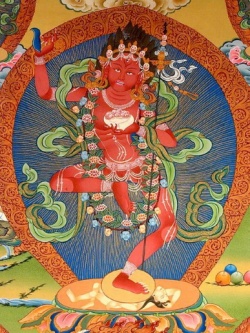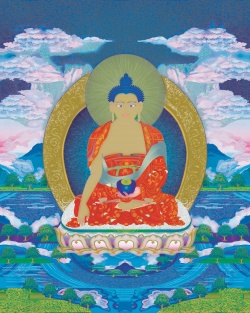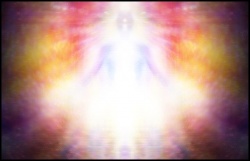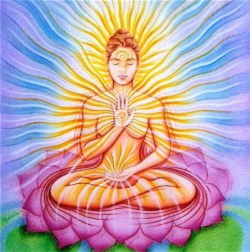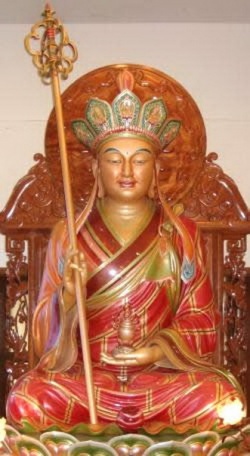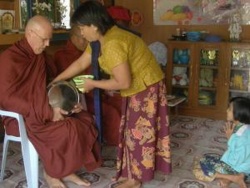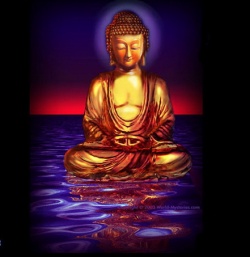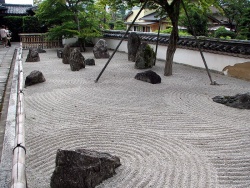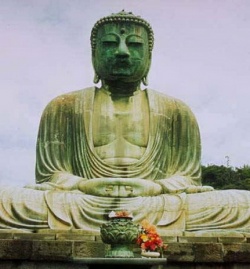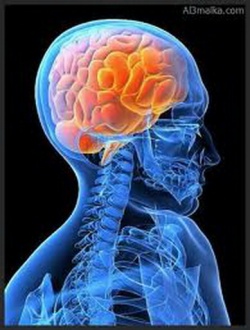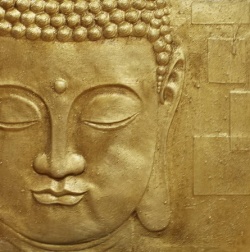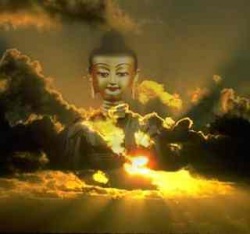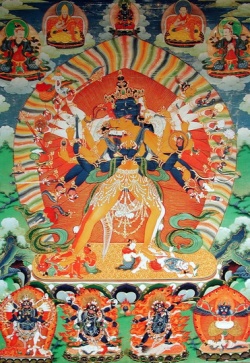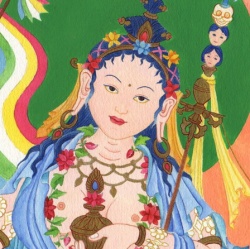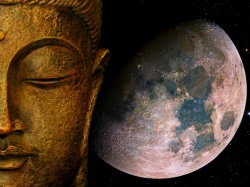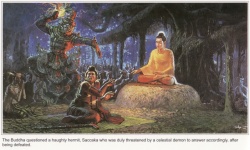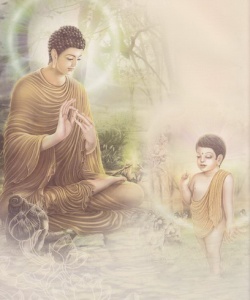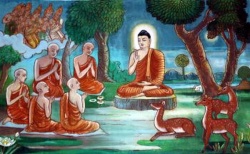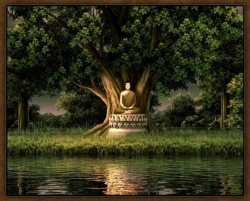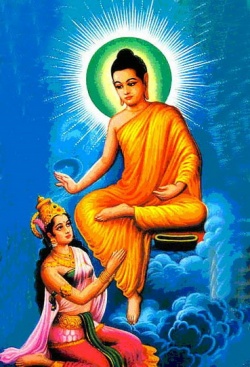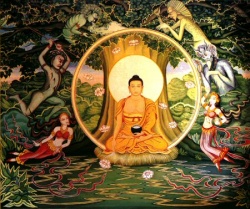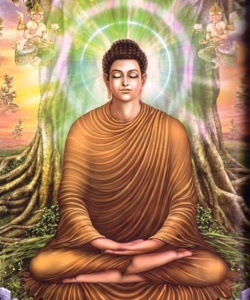How to Transform a Human Body into a Buddha Body
Part I
The terms "human body" and "Buddha body" occur rather frequently in Buddhist texts dealing with various stages of mental development and different qualities of materialistic sublimation. The Theravada teaches its disciples to purify the human body in which there are thirty-six items of impurity. The Mahayanists and the Vajrayanists lay more stress on the sublimation of voidness and the function of wisdom-energy. All have their merits and are correlated in certain order with definite aspects of Truth.
Without the purification of the human body, the transformation into the Buddha body would not be possible. Most disciples who rebuked the doctrine of the Theravada found it difficult to attain satisfactory results in their Mahayanist or Vajrayanist practices.
The philosophy behind the sublimation of voidness in the Tathata and the function of wisdom energy in the consequential position of Buddhahood is described in voluminous and lengthy writing which cannot be elaborated on in detail here due to want of space.
The Tung (note: Tang Dynasty Tantra and Japanese Tantra include a system called "The Five Forms of the Accomplishment of the Buddha Body". Many disciples often neglect the philosophy governing this system which will be touched upon briefly in this essay.
Mantras, mudras and some simple visualizations are well described in this ritual, but if one lacks the proper philosophical and practical foundation and meditates only on those fragments by fits and starts, it is like grabbing a handful of antique Chinese coins without properly stringing them: the transformation from human body to Buddha body will not be accomplished. I intend to present here, according to my own experience, the philosophy governing this system of the Five Forms and the connection between any two successive forms. These connections will link the five forms as one.
First of all one should thoroughly recognize "The Original Mind" as the first form is named. This means to disciples that besides Truth there is neither mind which the Idealistic School emphasizes nor matter which the Indian materialism and the modern materialism asserts. The truth is that the Dharmakaya is formless, colorless, and timeless. Before this yoga is practiced, this truth which is in changeless Tathata Samadhi or in the meditation of the seed mantra AH must be mastered in both its philosophical aspect and its concrete realization.
A penetrating recognition absorbed into the four dimensions of the dimensionlessness of the truth is not a common visualization to be seen through the worldly eyes of flesh of a disciple with a self-centered desire of attainment deriving from the sixth consciousness, along with the egoism of the seventh consciousness of the Avidya system. It is to be seen only through the Dharma-eyes of the Vidya system beyond the sixth consciousness and the seventh consciousness.
The disciple gets, at least, a vivid vision of the outline of the Dharmakaya in an edgeless sphere full of pure, holy, quiet, serene and victorious significance with luminous light in which there is neither the idea of self nor the idea of the existence of ones own body of flesh. Yet it is embracing everybody good or bad, in heaven or in hell, during the Buddha-Dharma period, the Symbol-Dharma period, or the Non-Dharma period. Thus at any time, on any occasion everybody shares it, although not everybody is aware of it. This is the head of the connection between the first and second forms.
Though the ritual emphasizes that there is a Buddha who sees the Disciple absorbed in the stable Samadhi of the original mind and being unaware of the great service of salvation of the Buddha who loudly calls him to awake, a disciple who is not thoroughly absorbed in Samadhi will be unable to detect this merciful calling. Nevertheless, as it is a method leading one towards consequential attainment, one should practice it with diligence. On the other hand, one who has developed the Bodhicitta in this lifetime, or who had practiced the Bodhicitta in many past lives, may recollect the original mind in his Samadhi. One will also visualize the Bodhicitta mind which is the second form, in the symbol of a full moon with a diameter of about eight inches. This is the end of the connection between the first and the second forms.
Our Bodhicitta mind consists of two great elements. One is the wisdom which is derived from the Truth of the Dharmakaya with which the first form is concerned. The other is the great compassion which one should develop here during the time when the second form is taking place in meditation.
When the insight of realization of the first form appears, one eventually knows that it is homogeneous in everybody. But, "Why have I seen it in such a quiet, happy meditation whereas many others who are suffering from different severe pains in the endless cycles of transmigration, could not obtain it? says one to oneself. As soon as such a question arises, the disciple may meditate in the following manner:
The disciple directs the holy light which is radiating from the moon of wisdom upon the heavens. With tears in his eyes, the disciple springs out from his Bodhicitta, and meditates on the following five signs of decay of the heavenly beings: i.e., uncontrolled discharges, flowers on the head withered, unpleasant odor, sweating armpits, and uneasiness.
He also throws this holy light upon the Asuras, on their sorrows of anger and pride, with which they fight with the heavens. Again he throws this holy light upon human beings, every single one bothered by the five sorrows, eight pains, eighty-eight delusions and four hundred and four diseases; he then throws the holy light upon the animals, on their calamities by nets, traps, poisons, guns, arrows, and knives;
again he throws the holy light to the hungry ghosts, on their small throats, big bellies and food of blood and pus; again he throws the holy light into the hells and hell-beings, on hills of knives, forests of swords and calamities of ox-headed and horse-faced demon-messengers; thus the disciple baths himself in tears and earnestly prays for his unfortunate fellow beings with a ray of hope to save them.
After the six worldly Dharmadhatus have had holy light thrown upon them, been meditated on, and prayed for, the moon light should be visualized as an offering to the four enlightened Dharmadhatus (Arhats, Pratyeka Buddhas, Bodhisattvas and Buddhas) and prayers for saving sentient beings should be observed in very profound devotion. When the light is drawn back, the disciple should believe that all four kinds of enlightened sages have blessed him with their wisdom, compassion and supernatural power.
Thus development of the Bodhicitta may be completely formed. Only devas, asuras, and ghosts or spirits of the higher rank who may read others?minds could know some of the good wills springing from the Bodhicitta of the disciple. Other sentient beings who are hidden by five obstacles, surrounded by five Kasayas or impurities, who indulge in the five Chandas, are perplexed by the five poisons and threatened by four demons, have no ability to accept the holy moon light which is so subtle and imponderable, so secret and inexplicable, and so holy and intangible. In fact, a disciple practicing such a form is not capable of saving them. This is the head of the connection between the second and the third forms.
To subdue all demons, to increase a disciples power to control all holy elements, to concentrate all wisdom and to purify all desires, there is an instrument in Tantra consisting of the five Buddhas?wisdom in its upper part, five holy elements in its lower part and the essence of the five Bodhicittas in its middle part. All form a Vajra which is material yet spiritual, and philosophic yet pragmatic. It is comparable to the diamond in such characteristics as hardness, essential indestructibility, power, infrangibility, and rigidity. The disciple should realize such a Vajra Mind, as the third form has been named. Here the mind should be expounded as the essence of truth and not as the sixth consciousness which the Idealistic School asserts.
Traditionally, this is never imparted by the ancients. However, when one corner of an object is shown, the other three corners of the same object would be inferred. In the Samadhi of the second form, a disciple might be spoken too loudly by the Buddha, "Without the attainment of Vajra-mind, you are incapable of saving sentient beings." This is the end of the connection between the second and the third forms.
After the Samapatti of this Vajra-form has been visualized firmly in its original size which is as ones own fist with the thumb erect, one should practice its several enlargements. Ones body, hermitage, the visible sky, and the invisible Dharmadhatu should be visualized in their respective order. This sequence has been established dialectically and philosophically by the writer through experience for the following reasons:
- The Chinese term "Hsin" has many meanings. It refers to the "heart" when it is used in the physical sense. It refers to the "mind," "will," or "wish" when it is used in the psychological sense. It means "center" when it is used geometrically. It means "soul" or "consciousness" when it is used in the spiritual sense. It means "essence" or "truth" when it is used in the philosophical sense. As it may mean something rather opposite, its relevant meaning depends on context and should be carefully discriminated and comprehended.
For the purpose of inducing ones thought into the whole truth, one should take the word as a whole with all its implications. But for other occasions, it should pertain to its appropriate meaning in each specific instance. The meaning of the word "Hsin" as used in connection with the size of the Vajra implies "harmonization", thus it embraces all its meanings. The reasons for the protoplasmic size of the Vajra to be meditated upon in the same place as where the physical heart lies are as follows: to give an origin to all its enlarged sizes; to impart its wisdom to the life-energy of the heart; to transform the soul or the eighth consciousness into the gnostic life of Buddhahood; to present a concrete embodiment of good will or wish and to strengthen the Bodhicitta of the second form. All the above reasons are relevant to the different meanings of the word "Hsin."
- Of the five forms in this Yoga, the first three forms have in their names the word "Hsin" which has been translated as "mind" while the subsequent two forms have the word "body" in their names. Naturally, besides the mind, the body is second in importance. The main subject of this Yoga is primarily connected with the body. Hence the enlargement of the Vajra should be identical with the size of ones own body. The five holy elements in the organs and five kinds of wisdom in the brain symbolized by the Vajra would gnosticize the organs and the brain of the human body and sublimate the body.
- It is said that all sentient beings of the six realms from the hells up to the heavens are under sky. Though it is not attempted at this point to measure the actual distance between the heavens and earth, the visualization of the Vajra should fill up all the space between the heavens and the earth. Hence all sentient beings of the six realms are blessed with this Vajra.
- When the size of the Vajra is visualized as equal to the Dharmakaya, the four enlightened realms mentioned previously would be inter-related. Arhats and Pratyeka Buddhas would feel that their Samadhis are now capable of attaining the Samyak Sambodhi, while the Bodhisattvas and Buddhas would bless the disciple as their true inheritor.
Furthermore, all the four different sizes of Vajras are in a permutable connection with one another as Cricoid rings linked outwardly and harmonized inwardly. When the heart Vajra is extended to the body Vajra, mentality and materiality are identified. When it is extended to the hermitage or mandala, its subjectivity and objectivity are identified. When it is extended to the Dharmadhatu Vajra, Garbhadhatu and Vajradhatu are identified.
When any one of the four Vajras is taken as the Chief, all Vajras of other sizes would encircle it as its retinue and a great interwoven function will take place.
When the Heart Vajra is chief, with its Bodhicitta mainly functioning, the unconditional compassion and the great mercy of the entities which exist in the Dharmakaya, the unlimited merits of all Gods in the skies, the Gurus, Yidams, Dakinis and Protectors in the hermitage or Mandala and the 32 forms of the incarnation of a Buddha-body, all function with the Heart Vajra with their good wishes and great vows.
When one takes the Body Vajra as the master, the other three sizes of Vajras are its subordinates and may be identified with one another. The more one emphasizes the negation of ones own human body, the better is the body in Buddhahood and the permeation and harmonization with the other three kinds of Vajra bodies. Thus the Buddha body in the Dharmadhatu, the bodies of Gods in the skies, the bodies of Gurus, of Yidams, of Dakinis, of Protectors in the Mandala of hermitage, the bodies of sentient beings who are pitied by the Vajra heart, are all identified permutably. There is neither any Buddhahood to be newly achieved nor any sentient being to be saved hereafter.
When one visualizes the Hermitage and its Mandala as the main Vajra taken as the head, the other three sizes of Vajra may be taken as the limbs. The Gurus, Yidams, Dakinis, Protectors and their Dharmakayas which refer to the fourth size, that of the Dharmadhatu, their great mercy which sheds tears coming from the first size of the heart, and their merits of Sambhogakaya which developed from the second size of a human body, are also co-existing and simultaneously functioning.
At last, if the utmost size of Dharmadhatu Vajra is visualized as the main source and the other three sizes as its subordinates, it will play at the great Indra net of Vajras and form a vast macrocosm of the Buddha world. And the function therefrom might be one as many, many as one. United yet separate, separate yet united; with the other three sizes of Vajra yet beyond all of them, beyond all of them yet in all of them; extensive as well as intensive; all behind it, yet all manifested in it; abstract as well as concrete; present, yet past and future act within it.
Today is the tomorrow of yesterday, and it is also the yesterday of tomorrow. In short, one minute includes all three periods of past, present and future. Thus the powers of the Buddhas in the three periods are working at the task of salvation at once without procrastination. Space and time are both under its control. The highest theory of exoteric philosophy and the highest practice of Yogic Tantra called Six-Element-Yoga here get the final chance of achievement; and all four sizes of Vajra Mind as the third form is named, have their function synthesized, identified, interreflected, interpenetrated, interpermeated and, at last, harmonized.
No matter how powerful the Vajra may be and how ingenious a disciple may be in his practice with the Vajra, it does not function as sound for preaching. That is why the Vajra is always accompanied with the Vajra-Bell. "Who will hold this powerful couple of Vajra and Bell?", the disciple will ask himself. Hence the practice of personification of the Buddha body should be carried out next. The Buddha would then call the attention of his disciple again. This is the head of the connection between the third and the fourth forms.
On the one hand, the "Vajra-Body" realization, as the fourth form is named, should accumulate all merits of the three kayas of Buddhahood. On the other hand, the three secrets of body, speech and mind are only available when the body is formed but not in the symbol of the Vajra. Hence, the personification is a crying need and the end of the connection between the third and fourth forms.
After the extension of the Vajra has been drawn back to the size of the disciples human body, a Vajra body of personification will be embodied. When the Vajra transforms itself into ones body, the upper part of the Vajra becomes his hair-tuft and the lower part of the Vajra becomes the medium nerve which is the main source of every part of the Buddha body. From the medium nerve, instead of the spinal column, the brain system arises and the blood circulatory system works, and all the inner and outer organs form. All these systems and organs outwardly appear to resemble those of a human body, but inwardly it is full of the wisdom and compassion of Buddhahood. Hence it is quite different from a human body which is formed by evil karmas only.
Some of the rituals emphasize the personification of Vairocana, others emphasize that of Samantabhadra. In the opinion of the writer, for practicing the basic Samadhi the former is better; for practicing the karma-function to benefit others, the latter is better as the position of a Bodhisattva is much closer to sentient beings than that of a Buddha. This Yoga lays more stress on the transformation into Buddha which should be like Vairocana. When the Buddha body is achieved and if the disciple wants to be a savior, Samantabhadra will do.
The term "body" has many purports: it means the entity that is the Dharmakaya; or it means the very Yidam himself, that is, the Sambhogakaya; or it means the body of the practitioner that is the Nirmanakaya in whose heart is the Bodhicitta. The body of entity pursues the truth of voidness; the body of the Yidam presents his characteristics such as his great pleasure and supernatural power. All Gurus, Yidams, Dakinis and Protectors are under his control. Thus the practice of the fourth form has accumulated all the merits of the previous three forms. The disciple should not mistake the body as the flesh one only; thus the synthesis of the whole Yoga would be wrongly recognized.
As the personification of the Vajra Body is from the wisdom Vajra, the 36 impurities are not in it. As the Vajra lives in the Mandala, there are no objects of attachment to lure it; as it manifests the Dharmakaya, there is no Satkayadrsi (a view that thinks of the flesh body as real) or ego-infatuation in it; and as it teaches gods and men, there is no demon who could harm it.
Furthermore, when such a personification is achieved by anyone who is in an entity of Tathata, he is always in the Dharmakaya. He possesses the same characteristics of a Guru, a Yidam, a Dakini, and a Protector, and is in a perfect and joyful Sambhogakaya. He is worshipped by every god and divinity, surrounded by sentient beings, and appears in the merciful Nirmanakaya.
According to ones complete development of the five forms, we may say that from the first form of Original Mind, which is the basis of Enlightenment, one has got the result of the position of Buddhahood; from the second form of Bodhicitta, which comes out of great compassion, one has got the foundation of salvation; from the third form of Vajra-Mind, a Buddhas karma might be carried out through its powerful functioning; from the fourth form of Vajra Body which is the embodiment of a Buddha body, one has got the perfect evolution of Buddha body; from the fifth form of the Perfection of Buddha Body which possesses all the merits of a Buddha, one will vividly achieve the transformation into Buddha body with all his values which will be elaborated later on.
As the Vajra has induced everything in its body when it personified objectivity and subjectivity, both being identified in the meantime, the macrocosm is in the body as microcosm. The spinal column is the Mount Sumeru; the four limbs are the four continents; two eyes are the sun and the moon; the urinary bladder is the ocean of milk; and so on. In the upper part of the body are sentient beings of the three higher realms; in the lower part of the body are those of the three lower realms. Outside the body are deities of every religion standing as protectors.
Inwardly 24 mandalas of Mahadeva Heruka arises from the 24 nerves which are derived from the right and the left great nerve. Secretly, there are the five Buddha departments in the five wheels (chakras); most secretly, there is the permanent and quiet holy-light realm of the Dharmakaya which is implied by the medium nerve. Hence every powerful God and Buddha have been included in the body.
Mencius said, "Where there is the meritorial quality within, it manifests itself without." The embodiment of the real Buddha in a person should constitute of all the inward qualities of a Buddha as well as all the identical signs of a Buddha. Hence, every merit of ones salvational virtue would manifest itself as plainly as the nose on ones face. The consequential position of Buddhahood, as it is so called in the Tantra, is achieved when one has attained the thorough realization of Buddha personification both within and without. One then is undoubtedly a real Buddha with all the inward qualities and outward signs.
The preceding four forms have achieved the great conditions of those of a Buddha body. It is only the details of its adornment needed now. This is the upper connection, where all adornments are perfectly visualized through the last form. Its name being the "Buddha Body Perfection," then there is nothing left. This is the end of the connection between the 4th and 5th forms.
A Buddha in the capacity of a savior is called the king of the revolving wheel of Dharma. All great merits and virtues which had been accumulated would appear as the 32 remarkable physical characteristics. These are the adornments of a Buddha body (Dvatrimsat-varalasana). They are:
- Level soles, indicating his attitude of equality towards anyone, anywhere.
- Thousand-spoke-wheel sign on soles, indicating the countless means of performance of good karmas.
- Long, slender fingers, indicating his good character of non-killing and non-stealing.
- Pliant hands and feet, indicating his service of washing and massaging his parents and patients.
- Finely webbed toes and fingers, indicating his excellent guidance to Buddhahood for all sentient beings.
- Full-sized heels, indicating his concentration on the Right Dharma.
- Arched insteps, indicating his kindness towards servants and maids.
- Thighs like those of a royal stag, indicating his thorough knowledge of all subjects.
- Hands reaching below the knees, indicating his far reaching almsgiving.
- Well retracted male organ, indicating his chastity.
- Height equal to the stretch of arms, indicating his faithful duty to others not less than that to himself.
- Dark colored roots of hair, indicating his power of Dhyana without signs of old age and decay.
- Graceful and curly bodily hair, indicating his honesty.
- Golden hued body, indicating his noble virtue in entity.
- A ten foot halo around him, indicating his holy light of Samadhi.
- Soft smooth skin, indicating his great compassion.
- Seven places (two soles, two palms, two shoulders and crown) well rounded, indicating his good karmas without prejudice.
- Well filled armpits, indicating his amiable bonhomie.
- Lion-shaped body, indicating his fearlessness in saving others and in subduing the demons.
- Body erect, indicating his straightforwardness.
- Full shoulders, indicating his dutifulness.
- Forty teeth, indicating his faithful speech without lies.
- White, even and close teeth, indicating his truthful, credible, immutable and unexcessive teachings.
- Pure white canine teeth, indicating his practice of the four infinite powers of interpretation.
- Lion jaws, indicating his ability to subdue outsiders.
- Saliva capable of improving the taste of all foods, indicating his accomplishment of Dhyana.
- Long and broad tongue, indicating his excellence of praising all Buddhas.
- Deep and resonant voice, indicating his realization of the truth of voidness.
- Deep blue eyes, indicating his right view in Tathata.
- Eyelashes like those of a royal bull, indicating his forbearance and perseverance in keeping his right view.
- A white urna or curl, fifteen feet long, between the eyebrows emitting holy light, indicating the source of his pure and bright Dharma; and
- A usnisa or fleshy protuberance on the crown of his head, of which no god could see the maximum, indicating his highest consequential position of Buddhahood.
Along with these 32 good forms of a Buddha-body, there are eighty handsome symbols on the Buddha-body to indicate his good characteristics in detail. Besides all the 80 handsome symbols and the 32 excellent forms of the Nirmanakaya, there are some important marks of the Sambhogakaya, i.e., the crown with the images of the five Buddhas to symbolize his five kinds of wisdom and the holy-light of silence surrounding him infinitely; there are also realization signs of his Dharmakaya, i.e., the Vajra and the Vajra-bell held in his hands, the sign of Vajradhara or Vajra Vidyadhara who is the Guru of the five Buddhas. Thus the complete Buddhas virtues are manifested on the Buddha-body and the holy work, the highest yoga of transformation from a human body to a Buddha-body, results in a successful process. Whenever the disciple is in his Samadhi of this yoga, he is quite of Buddha, as it were; whenever he is in his Samadhi, if any human nature appears, he would reflect upon it himself and change it immediately until his fundamental static Samadhi and his dynamic daily Yoga are identified.
To sum up the five forms of this yoga with similes: the first form of the Original Mind is like the seeds under the soil; the second form of Bodhicitta signifies the root; the third form of the Vajra Mind is likened to the trunk of the Bodhi tree; the fourth form of the Vajra Body is likened to the leaves and flowers; and the fifth form of the Perfect Buddha Body is likened to the fruit of full Enlightenment.
Nevertheless, this yoga is in the Yogic Tantra. There is the Anuttara Tantra with many lofty methods of transformation of the Buddha-body. As the Yogic Tantra involves only the practice of mentality together with the theory of Six-Element-Yoga, it is not a practice of wisdom-energy. The elaborate practice of visualization such as that of the Evolutional Yoga (utpatti krama) has not been included in the Yogic Tantra, much more so the nispanna krama which is never known to Japanese Tantrists. Those readers who are interested are advised to learn them from Tibetan Buddhism. For a complete and systematic study of the transformation of a Buddha-body, I have written a brief essay as Part II, based upon the doctrine of Anuttarayoga of Tibetan Tantric Buddhism.
Part II
The Anuttarayoga gives the more important details and unique technical psycho-physical practices which enable the practitioner to achieve success in transforming a human body into a Buddha body in this very lifetime. I shall deal with them in this booklet in a systematic way without quoting many trifling matters or Sanskrit terms which are unfamiliar and puzzling to the western reader.
In general, the Anuttarayoga contains the Six Secret Methods as edited by Naropa which Western Buddhists had been introduced to many years ago. In particular, each Yidam has his own Anuttarayoga with different stages thereof, e.g., the six stages, i.e., Vivekakaya-krama, Viveka-vak-krama, Viveka-citta-krama, Maya-dehadeha-krama, Prabhasvara-krama and Yugannadbha-krama, or the five stages, i.e., Vajrajapa-krama, Citta-visuddhi-krama, Svadhisthana-krama, Sukkadhisambodhi-krama and Yuganadbha-krama. These two above mentioned systems are in the Guhyasamaja Tantra.
The four stages, i.e., Visuddha, Dharma, Mantra and Sansthana are found in the Mahayama Tantra, and the six stages, i.e., Pratyahara, Dhyana, Pranayama, Dharana, Anusmriti and Samadhi are found in the Kalacakra Tantra. They are similar in most respects. All are under the classification of the Four Initiations or Six Secret Methods. In the Hevajra Tantra, which has been translated into English and published by Oxford University Press, all the practices have been divided under the topics of Four Initiations. However, without reading my booklet New No.
78 entitled "A Safe Guide to the Practitioner of Hevajra Tantra" one would not find out the exact practical sequence to be followed because the text handed down to us has been purposely confused for the sake of keeping it secret. Now our age is quite different from the ancient ones. People now have deep and curious interest in discussing the Truth, but have rather little faith in practice. Hence I now have to introduce it frankly and plainly and accurately without any perplexities and confusion.
An adumbration should be sandwiched in here before setting forth the statement about Anuttarayoga to complete the whole system of the Tantric doctrines concerning the Buddha-body.
- When one is practicing the Kriya Yoga, one is frequently connected with the Buddhas, Budhaesses, Bodhisattvas and Holy Gods (Gods who are Bodhisattvas). Just as a child is always copying the actions of his parents, so is the practitioner imitating all the good manners and appearances of Buddhas. He would not disregard himself as a sinner without recognizing the entity of Buddhahood. To make his connection to the Buddhas much deeper, he is taught to practice the following eighteen ways daily:
(1) To purify his sins enabling him to be close to the Buddhas.
(2) To ask the Buddha of the Buddha department to purify the crimes committed by his body.
(3) To ask the Buddha of the Lotus department to purify the scandal uttered from his mouth.
(4) To ask the Buddha of the Vajra department to purify the wickedness conceived in his mind.
(5) To wear the Vinaya-armour to protect the pure body.
(6) To build the diamond net around the place where ones hermitage is situated.
(7) To build the diamond wall around where one is living.
(8) To visualize the Mandala of Buddha within ones hermitage.
(9) To visualize the Maha Bodhisattva Akasagarbha to adorn this Mandala.
(10) To visualize a carriage to welcome the Buddhas.
(11) To guide the carriage to come rightly into the Mandala.
(12) To welcome the Buddhas when they are in the Mandala.
(13) To cover the Mandala with gnostic fire.
(14) To spread the Vajra net above the Mandala.
(15) To cover the gnostic fire all the places inside the Mandala.
(16) To offer holy water to the Buddhas for bathing.
(17) To offer a lotus for sitting upon. (18) To offer every other kind of good things.
In short, every action done by the practitioner is like that of a Buddha and not like that of a human body.
- When one is practicing the Carya Yoga, besides ones body which is connected to Buddhas body, the mind, which is the master of the body, plays an important part in this Caryayoga. In this practice there are four holy conditions: First, the practitioner should visualize himself as a Buddha body in the position of Cause; Second, in front of him, on the sky, there is visualized a Buddha in the position of Consequence;
Third, in the heart of the practitioner should be visualized a moon which indicates the Buddhas gnostic mind; Last, the moon should be seen in Buddhas body in front of the practitioner. Hence, through the movements of the incantation around the moon in both the Practitioners and Buddhas heart, ones wisdom is identified with the Buddha. The master of the human body is thus sublimated. The movement of the incantation is the life energy which is the chief energy among the five energies upon which a good foundation of the materialization of the Buddha body is well based.
- When Yogic Yoga is practiced, both the five forms of the Buddha body and the five elements of the Pagoda are identified. Then the philosophy of the Six Element Yoga which contains the mental element of Right View (or the ninth holy consciousness) and the five material elements is stressed more. The Buddha body and the palace of the Buddha body have gotten their good foundation. Starting from this stage there is no more differentiation between mentality and materiality, or the spirit and the flesh, or the mind and the body, or the psychical and the physical, or the metaphysical and material sciences. Every practice henceforth has no duality. It is real yoga, by which is meant the total unity of every opposite in total harmonization. One who practices this yoga and those yogas following henceforth should keep this point clear in mind.
Now I should introduce the main practices in the Anuttarayoga, i.e., the Evolutional Yoga and the Perfect Yoga.
I. The Evolutional Yoga
The Evolutional Yoga itself bears a name which is another title for the first stage of transformation of the Buddha-body. Here the body does not mean the flesh one only. It is {{Wiki|psychophysical]] and anthropomorphic. It cannot be separated from the mind of Samadhi of the Sunyata. Shame is mental, but the blood which makes the face red and the hair stand up is physical. They occur at the same time and cannot be separated. Though the practice of visualization is mental, the form which appears in oneself and others visual impression is vividly physical. Hence this practice of the visualization of the Buddha body in the last stages only contains some Mantras, Yantras, and Mudras. But in this evolutional yoga, the realization of these three conditions or standards are more stressed while those Mantras and Mudras are not so often practiced again. The three conditions or standards are:
- Clarity. All the hairs on the whole body such as eyebrows, eyelashes and so on should be visualized not only clearly in their outward appearance but so that the nature of Sunyata is obvious in every hair. Outwardly the hair is like a shadow in the mirror, but inwardly it is quite empty like a bubble. The hair is visualized thus and the other parts of the body which are bigger than the hair should also be visualized in the same manner.
- Firmness. After this Clarity is accomplished, to make this clear appearance durable throughout ones whole life without one second of disappearance, Firmness is the second condition to be held. Firmness must be kept with respect to quantity, not only all the parts of the body but also all the parts of the Mandala; and to time not only in meditation but also in walking, in talking, in sleeping and even in sexual intercourse. It may be likened to a wooden image which is engraved with a knife; the deeper you engrave it, the more obviously the lines stand out.
- Holy Pride of Buddhahood. As the human body is formed by the past profane karmas, so one may always consider oneself to be a man, just a common man who cannot become a God nor a Buddha. Once I asked a Father of the Catholic Church why Jesus asked God three times to remove the cup. The Catholic Father said it was His human nature. In [[Wikipedia:Christianity|Christianity]] even Jesus may have human nature, but to the Tantric Buddhist, human nature should be forbidden to appear. That is why one has to keep the Buddhas Pride instead of human nature. Though human nature is a bad seed in the field of the Eighth Consciousness, it is supported, persists and flourishes by ones own egoism.
If Sunyata meditations are practiced frequently, and the Buddha body visualizations are gradually increased, the Pride of Buddhahood will eventually be accomplished. One should think that since one is initiated and dignified by the wisdom-Yidam, who has no more human body, whenever one does, says, or thinks of something, one does it, says it and thinks of it respectively like the Buddhaones Yidam. One should offer peace where there is war, food where there is hunger and drink where there is thirst.
Whenever one meets with anger in someone, pacify it! A request from a beggar, grant it; an inquiry, answer it; a patient, cure him! If lustful thought arises from ones mind, one should ask oneself: Should a Buddha still have lustful thought? If selfish thought arises from ones mind, one should ask oneself; should a Buddha still have selfish thoughts? When evil thought is cut off, bad action cannot take place. Thus one not only accomplishes the outlook of a Buddha body, but also achieves a Buddha mind. What a pragmatical method there is in the Anuttarayoga!
To explain the distinction between human pride and Buddha pride, a few more words should be given. Human pride is a sorrow. If a good person is proud of the lot of good Merits which he has done, he could be reborn only in the Asura realm but not in the Heaven. And the false Guru who says, "You are a great sinner. I am the only Buddha in this whole world. You have to offer your wife, concubine, daughter and maid to me as my Dakinis; and your land, buildings, fields and gardens as my properties." These constitute human pride but not Buddha pride. The former always accompanies lust, anger, ignorance, and egoism. Whereas the latter accompanies non-egoism, Sunyata, compassion and vinaya. One should recognize them clearly.
As I have said, the surrounding or Mandala of the Buddha body should also be visualized with the above three conditions. Besides these, the indications or the symbolism of each part or thing in the Mandala should also be well meditated upon. As ones own body has been personified in Buddhahood, his place or rooms or hermitage should also be sublimated into Buddhas as Mandala. The diamond of wisdom is its foundation, the eight-fold paths are the pillars, the four-noble paths are the four memorial precious gates, lotuses, vajras and skulls are the materials forming the walls. Outside the walls are eight graveyards which manifest impermanence. Inside the Mandala, flowers denote wisdom, lakes reveal mercy, light indicates the Samadhi, voices utter the preachings and fires express the powers. Outwardly, they all appear as things; inwardly, they all are Dharmas; profoundly, they all are Samadhi of Sunyata.
Furthermore, based upon the philosophy of non-duality, inside the Buddha body one may have the Mandala, and outside the Mandala one may have the Buddha body. Body and Mandala are not differentiated. Every part of the Buddha body indicates a Dharma, and every part of the Mandala also indicates a Dharma. Body and Mandala both contain mentality and materiality. Both contain the nature of Sunyata inside and the conditions of Sunyata outside. Shadow in the mirror, mirror with the shadow; both are two, yet one and one, yet two. All dissimilar existences have their mutual penetration. Biwapa became a stone image.
Chunpolongo lived in a small bottle. Mandala yet Buddha body, Buddha body yet Mandala. Subjectivity is equal to objectivity. One Mandala may have one Buddha body or five Buddha bodies or nine, or thirteen, or one hundred and eight or an even larger number of Buddha bodies. The chief and the retinue are different yet harmonious, harmonious yet different. One in all, all in one. Milarepa was invited by many of his students. He appeared to every student simultaneously. The Wisdom Buddha body in the Pure Land may be invited into the Samaya Buddha body of the practitioner. The visualized incarnated Buddha body may be sent to the Pure Land.
The wisdom Mandala may be invited into the visualized mandala. These have been done by many accomplished Gurus on the occasions of Initiations. Either broad one or narrow one, either hidden one or manifested one, either present or future, either subject or object, either form or voice, either merit or demerit, whenever or whichever takes place or is in action, all the others and all the times are acting simultaneously. The so-called Evolutional Yoga is evolving in this mystic manner. From the Sunyata nature it is produced and with the Sunyata conditions it appears. It is not like the common things or beings, some of which grow in an arithmetical progression while others in a geometrical progression but it evolves in a philosophic and mystical progression. No matter whether one is able or unable to do it, one has to try to practice it in this way when one is working at this stage of the course.
Nevertheless, the above evolutional practice lays more stress on the visualization within which, though, the motive is the philosophy of the Six Element Yoga. Yet the right view mental element plays an important role and the five material elements have not yet been taken on the shoulders of the practitioner. To have many irons in the fire of visualization and of the exercises and meditations, the quality of the five elements of materiality should at least, if not more, keep balance with the mentality of Right View or the Ninth Consciousness and undertake all the steps of practices of Anuttarayoga. Hence the quality of the five energies themselves, the way they pass through, and the essence they move with, and these three things i.e., breath, nerves, and semen-like drops, should be taught in a gnostic way of Buddhahood. Then and only then the Buddha body under such a practice would not only be a visualized one but also a matter of fact one which will integrate the quality of the real Buddha body. This is the main work of the second great initiation of the Anuttarayoga.
II. The Perfect Yoga
A. Second Initiation
From coarse to fine, from gross to subtle, from vulgar to gnostic and from violent to quiet, the practice of breathing has been well taught and well trained in both Hinayana and Mahayana. This is a good foundation for Breathing in Vajrayana. Vajrayana doctrines have elaborately pointed out to the practitioner the five different energies with their different functions and roles in the different positions of the Buddha body. When the practitioner practices the Tomoyoga in this second initiation, he should do it in the following sequence: first, practice the light bottle-like deep breath; second, the heavy bottle-like deepest breath until a certain degree of realization is attained, and the different functions of the five are utilized. These foolish and ignorant Hinayana believers usually say that they also have breathing practice. This is just like primary school pupils saying that they too have science and mathematics like those in high school and college. Actually they have not even dreamed of the names in differential calculus and integral calculus and how could they recognize the theory of relativity put forth by Einstein who was inspired by the non-absoluteness of Buddhism? My good readers, if you are still a Hinayana believer, please open your mind to learn more doctrines of the Tantra. It will not harm you even though it may be very hard for you to benefit from it.
- 2. The Holy Nerves
The way which lets the wisdom energies pass through is the gnostic nerves. The lioness?milk should be kept in a precious bottle, not a bottle of inferior quality. All the gnostic nerves belong to Buddhahood. The most important median nerve is a representative of the Dharmakaya; the two great nerves on the left and right sides of the Buddha body and the main seven wheels around the median nerve are pertaining to the Sambhogakaya; and the small nerves pervading the whole body are of and in the same Sambhogakaya yet it produces Nirmanakaya. There are 12 wheels in the four limbs, 30 wheels in the fingers, 30 wheels in the toes and 72000 fine nerves under the skin.
Besides the five energies which pass through different nerves, there are four-fold holy things which are contained in the nerves. Outwardly, the ten Dharmadhatus, the great universe; Inwardly, all the Gods, Angels, and Asuras of the heavens; Secretly, all the Protectors, Dakinis and Bodhisattvas; Most secretly, all the Herukas and Buddhas. All stay in the nerves and within their different Mandalas. The above three realizations or conditions of the visualization, i.e. Clarity, Firmness, and Buddha-Pride, should be practiced with all these nerves.
Most modern authors either of the East or of the West mistake the human body as the Buddha body. They like to say that the median nerve is in the spinal column, and the two great nerves left and right are the sympathetic and cerebral spinal system or the arteries and veins, that the five main great wheels are the five organs, and that the wisdom drops within the five wheels are the different hormones. This is quite wrong. The human body has been meditated away when one practices the doctrines of the Hinayana.
Impermanence meditation and the nine meditations on a dead body concern the human body. After one has gone through the eight voidness meditations of non-egoism in the Mahayana, ones body of flesh and blood has been cast behind the scene. A body of meditation is brought out. When one practices the Buddha body in which there are only wisdom and compassion, only meditation and light, nothing of flesh should be thought of, no spinal column or any other thing. Each of them may be "corresponding to," but not "is." Before ones body is really transformed into a Buddha body these correspondences are important. One has to take more care of them in ones daily life but not in the meditation of a Buddha body as the latter has its own whole system which does not allow any flesh thing to appear or to be thought of in the meditations.
Furthermore, each of the main wheels surrounding the median nerve has its special function when breath and wisdom drops are well controlled, and certain supernatural powers may manifest. The wheel of the hair-tuft may open a holy gate to the Pure Land and the yoga of Phowa which enables the practitioner to transmit his own consciousness into that of Buddha Amita or any other Buddhas. The wheel of the head may get heavenly eyes to see everything under the heavens, and heavenly ears to hear every voice of the heavens and earth and enable the practitioner to get the light of the Dharmakaya.
That is why it is also referred to as the Dharmakaya wheel when the five kayas are dealt with. The wheel of the throat may succeed to make one skillful in dreams and in the four kinds of holy abilities for debate, and enable the practitioner to attain the position of Sambhogakaya. The wheel of the heart may get the supernatural power to read others?minds and enable the practitioner to obtain the Sahajakaya or Svaghavikakaya. The wheel of the navel may get the supernatural power of knowledge to know the past lives of oneself and of any others and enable the practitioner to get the Nirmanakaya. The wheel of the abdomen may get the supernatural power of a magic body and enable the practitioner to get the Mahasukhaprajnakaya through vajra love practice.
- 3. The Wisdom Drops
Regarding the wisdom drops, the Ancients used to classify them into four kinds: drops of food, drops of breathing, drops of incantations, and drops of wisdom. Drops of food are semen or ova belonging to the human body. Drops of breathing are energies. Drops of incantations are bijas and true words. These three are pertaining to the lower three Tantras. It is only the drops of wisdom belonging to the Anuttarayoga which should not be confounded with the semen as those ancient authors had done. Many Tibetan famous works have mentioned that all the organs, such as the heart, liver, stomach, kidneys, spleen and pancreas are formed from drops of food.
In short, except the energies and the nerves, all parts of the body belong to the drops of food. They are different from one another by the degree of purity. In my opinion, all those parts are only of the flesh body which should be treated as an impure thing as Hinayana doctrines have taught. The Buddha body has only wisdom drops which should be practiced in Anuttarayoga under the second and third initiations. At the bottom of the median nerve are situated the red wisdom drops which is the Tomo and the wisdom essence. At the top of the median nerve are the white Wisdom drops which are the great compassion through wisdom. The former contains the five elements in general but water in particular. After they are mixed with each other, the other three elements will be produced and by their different qualities, colors, and functions, the fire element and five wisdoms will be completely produced and entirely worked upon.
Each drop contains a Buddha and his Pure Land. It may be a great one as the Dharmakaya which used to be called the "Only-One-Drop," and also may be as many as the different Herukas and Buddhas and Sambhogakayas and Nirmanakayas.
What is the form and color of a wisdom drop and who has seen it? Many Tibetan works mentioned only a few words on this topic. The wisdom drop is round in form and the size of a garden pea, qualified with four characteristics: i.e., (1) round and perfect, (2) clear and transparent, (3) bright and clean, (4) merciful and moist. But Majerabdro, the mother of Prajna Paramita, described it more elaborately: It is in the form of an egg with light; the size of the small finger and smooth like oil; and with the color of the blue gem of the holy place named Bubhali. In the cave of Bubhali there is a hermitage called Sambhapa which is a triangular palace of the Holy Dharma surrounded with a rainbow.
It looked very beautiful and maintained every kind of virtue gathered with many holy beings such as Dakinis, Bodhisattvas, Buddhas and Herukas. The wisdom drop also has all these merits. And she also said: "I lived in a forest of Chandan trees in which there is a special bird with the name of Goshun. Its plume is blue with a tinge of dark green. Its wings are marked with white crescents. Its tail is bright and in five colors, under its feet there are white conches. It has a white beak, white toes and red eyes. Its neck and head are like those of a peacock. On its crest stand three long red feathers from which it shines many rays of light. Bees cannot come close to it.
It does not kill any insects. It always stands on the flowers and never walks on the ground. It repeats only the incantation of Taraour Holy Mother, in a very pleasant sound. Whenever its mind is pleased, it repeats the incantation as a bliss to the person who meets with it. Otherwise, it does not do so. It feeds on the buds of good scented flowers and some medicine herbs. Sometimes it likes to stay on the branches of the Camphor tree and sleeps on large and good scented flowers like the Lotus. It possesses good characteristics and beautiful countenance. Its eggs are rare, a female Goshun lays only two eggs; one will be hatched out to be a male, and the other a female.
They are usually laid on the camphor tree. The chicks grow up with the blessing of our holy mother Tara. That is why this bird is called the incantation of Mother Tara. Its stool is a good medicine. Whoever takes it, the four hundred and four diseases will not harm him. When the stool is made into a holy pill and is kept on ones body, one myriad and eight thousand disorders or calamities will never bother the keeper. When it is mixed with oil, any kind of sore may be cured. Anyone who eats the meat of Goshun after its death may get accomplishment of worldly things. One who offers its feathers may get excellent achievement of Buddhahood. One who sees its countenance or hears its voice at least will not fall. The people who live in the forest of Chandan trees on which it stays will never be reborn in the three bad realms.
This kind of holy bird is very rare. If ones merits are not great enough one could not meet with it. It always preaches to the bees and other insects. It helps them to get a good rebirth in the heavens. When the chicks grow up they fly far away and never come back; it is a kind of renunciation. They build their hermitage until they lay two eggs, then they fly away. This is their traditional habit. Those eggs are scarcely seen by persons, even those with no sins. The holy bird is an oriole, but its head is a little longer than that of an oriole. The egg shell is reddish white. It is transparent and smooth. It emits rays of light twelve feet long in five colors which indicate the five wisdoms.
Inside the egg there are five-fold of lights. The light of the outermost circle is white, that of the second circle is red, the third is green, the fourth is blue, the fifth is like the cloudless sky. Inside the fifth circle there is a drop in the size of a mustard seed in the light of mixed colors which is the entity of Sunyata. It is like the moon in the water and the shadow in the mirror. This mixed colors is in six different hues which show the Darchichon and his five disciples of Buddhahood. This egg possesses many good virtues. The wisdom drop of our Buddha body should be visualized like this."
As far as I have read in Tibetan Tantric works, there is no more detailed description than this. For emphasizing the practice of the wisdom drop, I introduce it to the readers. We should know the quintessence of the Buddha body is the wisdom drop which is the crystallization of the Dharmakaya, the bliss-coagulation of Sambhogakaya, and the compassion-seeds of the innumerable Nirmanakayas. It is the holy life when it is transmitted into Amitas mind, one becomes Amita Buddha; into Cakrasambharas mind, one becomes Cakrasamabhara Buddha, into any other Buddhas mind, one becomes the same Buddha as him. It is the body pleasure from which victorious and transcendent light is issued and the Sahajakaya is formed. It is the perfect wisdom from which the great bliss reaches its maximum and the Mahasukha Prajnakaya succeeds which is the highest aim of the Vajrayana and which is never dreamed of by the believers of Mahayana and those of Hinayana.
For a distinguished study, I should state a few more words. Though semen may correspond with the wisdom drops, they are quite different. The former is produced by sorrow of lust and pertains to Avidya, while the latter is produced by wisdom of Sunyata and belongs to Vidya. When one gets the initiation of Vajrayana, he is born from the parents of Dajeechongthe Guru. Original Buddha nature is in his Sunyata nature and has been drawn out and brought to the Gurus body, passed through his median nerve to the Gurus Vajra while holy sexual intercourse with his Dakini is going on and sent to her wisdom womb and through her double bliss, a wisdom child is born. This is an infant of a Buddha body. After the practitioner has been initiated, the real Buddha body is united with the new born Buddha body and his wisdom drops is a crystallization of Buddhss wisdom and Buddhas great compassion. There remains no egoism or lustful sorrow.
All the above three holy factors or energy, i.e., breath, nerves, and drops, form the Buddha body which is not only materialized but also harmonized with the truthnon-egoism or Sunyata. They are three in one and one in three. When the Sunyata nature covers all the Sunyata conditions, it is the Buddha body of Dharmakaya or so-called the "Only-One-Wisdom-Drop." When it functions and manifests in Sunyata conditions, it is the Sambhogakaya and Nirmanakayas and they play a lot of mystic transformation for the sake of salvation. They are the three holy wisdom things in the Buddha body that have their certain orders and rules. And all these practices are the means to reach the Consequence of Buddhahood. He is taught by the Buddha Himself and may be successful in this lifetime.
Why does a practitioner still need the Third Initiation? The reason may be found in the following.
B. Third Initiation
Though all the practices have already formed the materialization of a Buddha body, a practitioner still needs to integrate the Buddha body much more perfectly through the help of a Dakini. Just as a human body is formed by some main conditions, i.e., fathers semen, mothers ovum and the consciousness of the being itself, so is the Buddha body which needs the Buddhas wisdom drop, the Dakinis wisdom drop, and the practitioners?ninth consciousness. A male practitioner has more wisdom drops of Shakta but less wisdom drops of Shakti; a female is vice versa. The males whole body is of Shakta, only the reproductive organ is Shakti; and the female is vice versa. During holy sexual intercourse, the Lotus and the Vajra both draw in their own supplementary drops mutually. There are still some other reasons for the necessity of the practice of Vajra Love.
The physical feature of a male is the sign of skillful means and compassion but that of female is wisdom. The lines and curves of the females breasts and hips are attractive and beautiful which are the signs of wisdom, the manner of the male are the signs of skill, strong muscles and rough. They need to help each other.
As the median nerve is the palace of wisdom or of Dharmakaya, the three things which get through this nerve, (breath, nerve, and drop) are sublimated into Buddhas wisdom. The two ends or two gates of this gnostic nerve should both be practiced by the practitioner. The upper gate is used to practice the Tantric breath while the lower gate, that is the reproductive organ, should also be used to practice the vajra love. Hence through both gates comes the wisdom energy from the male Buddhas and female Dakinis. It may shorten the time to achieve full Enlightenment.
To get rid of lustful sorrow by escaping is a method of Hinayana; by treating it as voidness of Dharma is a method of the Mahayana; but by penetrating it, subduing it and making it as a means to save others is a method of Vajrayana. The higher the wisdom, the deeper the sorrow it may subdue. It is just as seeing a robber we should go after him and seize him. If we want to get a tiger cub we must go to the tigers den. When we are poisoned we apply an antidote which is the poison itself to counteract with poison. When water blocks the ear we may use more water to wash the water out. When we fall down on the land we get up by supporting ourselves on the same land. Readers are advised to read my book Buddhist Meditation: Systematic and Practical and booklets New No. 47, 72, and 78; from these you will find out many good reasons for the practice of Vajra love.
Besides the reasons theoretically recognized, the secret methods of practice should be learned from the Guru personally. This kind of instruction is not printed or written but is obtainable only by oral instruction and impartation. One should find a Guru who has such experiences and such a Guru from his own diligent practices may get some new methods which are suitable for this modern age.
By looking at the attractive countenance of the Dakini one practices the non-duality of Form and Sunyata; by listening to the articulate intonations of the Dakini, one practices the non-duality of Sound and Sunyata; by snuffing at the musky perfume of the lotus of the Dakini, one practices the non-duality of Smelling and Sunyata; by taking the nectar through kissing the Dakini, one practices the non-duality of Taste and Sunyata; by embracing, kissing, scratching, rubbing and squeezing every part of the body of the Dakini, one practices the non-duality of Touching and Sunyata. If any kind of non-duality loses some degree of Sunyata Samadhi, sexual intercourse should be forbidden until and unless pleasure and Sunyata both balance each other.
The great pleasure wisdom nerve of a Dakini is called the wisdom conch-like nerve which is in the lotus and is the end part of her median nerve. Its tip is very small and short. There are many kinds of medicine to extend it until it is able to be inserted into the urethra of the practitioner. When the two median nerves touch, Shakta and Shakti energies pass and the wisdom drops exchange, then the four Sunyata and four bliss are harmonized in a great Samadhi of non-duality. Full Enlightenment may result and the perfect yoga will make the Buddha body perfectly integrated.
C. Fourth Initiation
Why does a practitioner need the Fourth Initiation? It is said by the Ancients that the Third Initiation is the cause of the fourth and the fourth is the consequence of the third. When vajra love has been practiced rightly and skillfully, the holy light of Dharmakaya will appear and this is not easily detected by the practitioner without the witness of the qualified Guru who has the experience to recognize it. On account of that there are many kinds of holy lights, the one which is the very one of Dharmakaya can scarcely be determined by the practitioner. For instance, Jesus?light could make Saint Paul blind, God Jehovah forbade Moses to touch his light. Our Lord Buddha who shone his light many times and much brighter, never harmed any audience on any occasion.
The light of Sambhogakaya illuminates much more than the Nirmanakaya, and the Dharmakaya light is the most excellent and transcendent and different from every other light. It should be identified with the truth of non-egoism. It contains many special characteristics as stated in the doctrine of Mahayana and Vajrayana but it is not dreamt of by any Arhat of Hinayana. There are no applicable modifying words or gnostic descriptions to clearly, apparently, and accurately describe this kind of light. It can only be certified by a personal Guru who has himself had the experience. There is no other kind of practice to teach this. But if false holy light appears the Guru can just point it out and ask the disciple to practice again according to the practical rules of the Third Initiation until realization of the Dharmakaya is actually attained.
III. The Great Perfection Yoga
The new Gelugpa party does not believe in the Great Perfection Yoga. The doctrines of the Great Perfection of Nyingmapa were found by sages in the earth, caves, the sea, and other hidden places. The doctrines were hidden by the great Guru Padmasambhava in Tibet and were not imparted from India. Some of these doctrines might be false ones, but some of them are quite worth while to practice.
As the holy Dharmakaya light is difficult to get, it is especially hard to get the realization of a rainbow body which not only achieves the holy light without death, but also makes the flesh body transform into a body of holy light without death, but it is only the great Guru Padmasambhava who has achieved this.
Sixty-four great volumes have been edited by the Nyingmapa sages. In most parts, Mahamudra and Mahayana meditations are mixed and mentions of the quintessence of the Great Perfection are very few.
Usually it is divided into two great sections: one is Checho which is the philosophy and practice of View, or somewhat like Chan. The other is Togar which contains many wonderful methods to practice with the sun and moon in a special position at certain times, toward certain directions and in a specially built hermitage.
To shorten the time of accomplishment, a very powerful and fruitful method called "Getting the Buddha-body in Only a Week" is taught in the Nyingmapa School. One who reads it only once may not fall. I have introduced it in my book Buddhist meditation: Systematic and Practical.
IV. Supplement Concerning the Human Body
Through the methods in the previous booklet Part I and in this booklet Part II, I have introduced in simple language all the essentials to achieve positively a Buddha body.
But how the body of flesh is destroyed negatively shall be related below.
- At the very beginning when one takes refuge in the Three Gems, one is aware of the human body which is very dangerously threatened by the family, the nation, demons and desires. One seeks only the Buddha body which is quite free.
- When one is taught with Hinayana doctrine, he is afraid of the impermanence of the body which will die at an uncertain time and in an uncertain manner. The time may be today or tomorrow. The means may be by disease or by murder. One seeks only a Buddha body which has neither birth nor death.
- The nine kinds of meditations on a corpse to curb desire should be practiced:
(1) its tumefaction, (2) its bluish mottled color, (3) its decay, (4) its mess of blood, (5) its discharge of pus from rotten flesh, (6) its being devoured by birds and beasts, (7) its dismemberment, (8) its bones, (9) its reduction to dust and gas. These are practiced with tears.
One who has practiced these thoroughly would not love ones own body any more but seek only a Buddha body.
- The thirty-six parts of a vile body which are unclean and impure are also meditated upon. One should neither love his body nor the body of one of the opposite sex in spite of its beauty. One only seeks the pure body of Buddhahood.
- As one does not like ones own body so one does not seek any beautiful, melodious, fragrant, sweet and soft things; but for practicing the Dharma, one has to suffer with ones body. That is why the twelve Dhutas, or disciplines are taught and eventually performed. They are:
(1) to have garments made of cast-off rags, (2) to possess only the three Buddhist garments, (3) to eat only food which is begged, (4) to have only two meals, i.e., breakfast and the noon meal, (5) to take no food between breakfast and the noon meal, (6) to take limited amount of food, (7) to dwell as a hermit, (8) to dwell among tombs, (9) to dwell under a tree, (10) to stay under the open sky, (11) to stay anywhere, and (12) to sit but not to lie down. One seeks only the Buddha body which is of Dharma but not worldly. The common people shamelessly pursue only delicious dishes, beautiful clothes, expensive buildings, nice concubines, and vast farms. A practitioner would have only pity upon them.
- When one practices the meditations of Mahayana, one should give alms with ones body, partially or thoroughly. Many Bodhisattvas set examples by their own sacrifice. Some offered their ears, others their blood, arms or even their heads.
- With ones body one learns to bear the striking, biting, kicking and tearing by others, as Lord Buddha taught us in the Diamond Sutra with his personal example.
- The practitioner meditates on his own body to be void both outside and inside, and on anothers body, either of a handsome boy or of a beautiful girl, to be empty.
- The ego which is master of the body or the tenant of the house should be fundamentally treated as emptiness.
- When one practices the methods of yoga in Vajrayana, one should visualize both the outside surrounding of the body and the inside of the body as void.
- There is an incantation of Sunyata to be repeated at first and followed with the visualization of voidness.
- A wisdom fire should be meditated upon to burn the body until nothing remains.
- Even the visualized Yidams body should be meditated upon as empty.
- Suicide is forbidden by Vajrayana, instead of which there is the practice of self-sacrifice through visualization which is emphasized by every school including the Yellow School. The head is cut and the skull is used as a great boiler; the four limbs and the internal organs are cut into pieces and put into the boiler to be offered as a meal. Ones own body is thus treated as an offering to the Buddha, Dakini, God and deities, and as an almsgiving to the demons, spirits, ghosts, creditors, and enemies of this and past lives.
- When one is sleeping one should treat his body as a corpse and keep his mind united with the light of the Dharmakaya.
- When one is dreaming one should keep his Buddha body meditation and do everything as a Buddha does in a dream. Thus one transforms everything, every person and every place into those of Buddhahood.
- When one is dying one should practice the holy light of Dharmakaya.
- When one is going to get another holy rebirth one should remember the Phowa yoga and directly go to the Pure Land or get a rebirth in this Saha world by choosing the good womb and being born as a boy of good parentage at will.
- There are four methods to prevent one being born in the four kinds of birth of ordinary beings:
- To prevent a birth in the moisture body as a fish or a worm one should visualize the word PON arising from Sunyata.
- To prevent a birth in viviparous body as that of a mammal, one should practice the visualization of a Lotus in the heart.
- To prevent a birth in the metamorphic body as that of a moth from the chrysalis or as a deva or in hells one should visualize a moon on the lotus in the heart.
- To prevent a birth in an oviparous body as that of a bird, one should visualize a bija on the moon in the meaning of Sunyata. Hence there is not any chance for a flesh body of non-Buddhism to be reborn.
A needle should be sharp only on one end, the other end should have a hole but not be sharp. He who cherishes his flesh body has to lose his Buddha body. He who seeks the Buddha body, should practice this doctrine and willingly lose everything of his flesh body. The Buddha body is naturally in ones own ninth consciousness. The good chance for finding it out is equal for everyone. Time waits for nobody. The later you practice, the later you succeed. To read only about the doctrine without practicing is like looking at delicious Chinese dishes without tasting them. So please determine to practice this doctrine as soon as possible.
